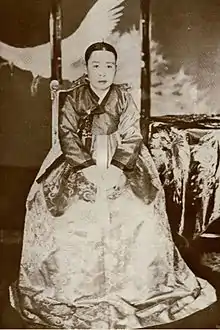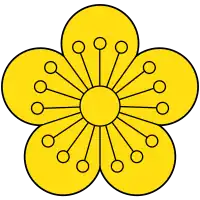Empress Sunjeonghyo
Empress Sunjeonghyo[lower-alpha 1] (Korean: 순정효황후; 7 September 1894 – 3 February 1966),[1] was the second wife and first Empress Consort of Sunjong of Korea, the last ruler of the Korean Empire.
| Empress Sunjeonghyo | |||||
|---|---|---|---|---|---|
 15–16 year old Empress Sunjeonghyo, ca. 1910 | |||||
| Empress consort of the Korean Empire | |||||
| Tenure | 23 July 1907 – 29 August 1910 | ||||
| Predecessor | Empress Myeongseong | ||||
| Successor | None | ||||
| Crown Princess of the Korean Empire | |||||
| Tenure | 24 January 1907 – 23 July 1907 | ||||
| Predecessor | Crown Princess Min | ||||
| Successor | Crown Princess Euimin | ||||
| Born | 7 September 1894 Munho-ri, Seojong-myeon, Yangpyeong County, Gyeonggi Province, Joseon Dynasty (now South Korea) | ||||
| Died | 3 February 1966 (aged 71) Nakseon Hall, Changdeok Palace, Jongno District, Seoul, South Korea | ||||
| Burial | |||||
| Spouse | |||||
| |||||
| Clan | Haepyeong Yun clan (by birth) Jeonju Yi clan (by marriage) | ||||
| Dynasty | House of Yi | ||||
| Father | Yun Taek-yeong | ||||
| Mother | Internal Princess Consort Gyeongheung of the Gigye Yu clan | ||||
| Religion | Korean Buddhism | ||||
| Korean name | |
| Hangul | |
|---|---|
| Hanja | |
| Revised Romanization | Sunjeonghyo Hwanghu |
| McCune–Reischauer | Sunjŏnghyo Hwanghu |
| Birth name | |
| Hangul | |
| Hanja | |
| Revised Romanization | Yun Jeungsun |
| McCune–Reischauer | Yun Chŭngsun |

Biography
Early life
Sunjeonghyo was born Yun Jeung-sun (윤증순; 尹曾順) on 19 September 1894 in Seoul. She was born to Lady Yu of the Gigye Yu clan and Yun Taek-yeong, a member of the Haepyeong Yun clan and an official of Joseon.[2] Her paternal grandmother, Lady Hong, was from the Pungsan Hong clan, descending from Princess Jeongmyeong, daughter of Seonjo of Joseon and Queen Inmok; Lady Hong was also a third cousin twice removed of Lady Hyegyeong.[3]
Through adoptions within the Haepyeong Yun clan, she was an 11th great-granddaughter (or 11th great-grandniece, biologically) of Yun Du-su; Yun Posun, the 2nd President of South Korea, was her ninth cousin three times removed.[4] On her mother’s side, Yun’s maternal grandfather, Yu Jin-hak, was a maternal adoptive nephew of Queen Sinjeong; thus making her the adoptive great-grandniece of the late Queen.[5]
Marriage and life in the palace
To how Lady Yun was chosen to be the next wife of crown prince was from the help of Imperial Consort Sunheon.[6]
Prior to the marriage, the Imo Incident of 1882 had forced Empress Myeongseong to flee from the palace, which brought Eom to demonstrate extreme loyalty to Gojong. The imperial consort, known at the time was Court Lady Eom, and the king became close during that time until Queen Min returned to the palace.
In 1885, the Queen consort expelled Eom from the palace when she discovered Eom wearing Gojong's clothing (seung-eun) at the age of 32. Her expulsion stripped her of her position and title, but a high-ranking official, Yun Yong-seon, Lady Yun’s grandfather, purportedly interceded on her behalf with Gojong, and she was forgiven. Eom never forgot the grace of Yun Yong-seon.
Because the seat was vacant, Imperial Consort Sunheon recommended the adoptive great-granddaughter of Yun after Crown Prince Yi Cheok’s first wife, Crown Princess Consort Min, died on 5 November 1904.
Yun Jeung-sun married the 32-year-old Crown Prince Cheok on 24 January 1907 at the age of 13. When she became Crown Princess Consort, her mother was given the royal title of "Internal Princess Consort Gyeongheung of the Gigye Yun clan" (경흥부부인 기계 유씨; 慶興府夫人 杞溪 兪氏) while her father was given the royal title of "Internal Prince Haepung Yun Taek-yeong" (해풍부원군 윤택영; 海豊府院君 尹澤榮).
On 20 July 1907, she became Empress Consort of Korea when her husband ascended the throne after the forced abdication of his father, Gojong of Korea. The Empress was demoted by the Japanese government by the Japan-Korea Annexation Treaty of 1910 and thereafter officially known as Her Majesty, Queen Yi of Korea (this title, however, was ignored in Korea).
Because of her demotion, she was known by her given alternative royal title as Queen Yun (윤비; 尹妃) and lived at Daejojeon Hall. But when she was given the royal title of Queen Yi of Changdeok Palace (창덕궁 이왕비; 昌德宮 李王妃), she eventually moved into the palace’s Nakseon Hall when her husband’s health worsened.
Empress Sunjeonghyo became a widow on 24 April 1926, when Emperor Yunghui died without issue at the Changdeok Palace in Seoul. Emperor Yunghui had been rendered infertile (and was also said to be mentally disabled) by poisoning in the 1898 Coffee Poisoning Plot.[7][8]
In 1939, the Queen’s family clan was pressured to change their family name to a Japanese surname. At the time, Sōshi-kaimei was a policy of pressuring Koreans under Japanese rule to adopt Japanese names. But her uncle, Yun Deok-yeong, opposed such a thing to happen and maintained their Korean surname.
Korean War
During the Korean War, Empress Sunjeonghyo stayed in Changdeok Palace as long as she could in the face of advancing forces from North Korea. During the war, the soldiers of North Korea invaded the palace but she reproved them and drove them all out. She then escaped secretly to the Unhyeon Palace when the war situation became too serious. As the war progressed, she moved to Busan with other Imperial family members, including Princess Hui (wife of Prince Wanheung). According to The World is One, Princess Yi Bangja's autobiography, Empress Sunjeonghyo went to Busan on foot.
After the Korean War

After the war, the new government of President Rhee Syng-man, jealous of the popularity of the Imperial House, prevented Empress Sunjeonghyo from entering the Changdeok Palace. She was kept imprisoned in Suin Hall, a narrow and unsuitable cottage in Jeongneung, Seoul. After a change in government in 1961 she returned to Nakseon Hall, Changdeok Palace with her dutiful ladies-in-waiting: Park Chang-bok (d. 1981), Kim Myung-gil (d. 1983) and Sung Ok-yeom (d. 2001), and five other staff.
Empress Sunjeonghyo became a Buddhist in her later years. She died childless on 3 February 1966, aged 72, at Nakseon Hall, Changdeok Palace, Seoul from a heart attack. She was given a state funeral and a private Buddhist funeral. She is buried beside her husband, Emperor Yunghui and his first wife, Empress Sunmyeong, at the Yureung Imperial Tomb.
Family
- Great-Great-Great-Great-Great-Great-Grandfather
- Yun Sang-myeong (윤상명, 尹商明)
- Great-Great-Great-Great-Great-Grandfather
- Yun Deuk-il (윤득일, 尹得一)
- Great-Great-Great-Great-Grandfather
- Yun Myeon-dong (윤면동, 尹冕東)
- Great-Great-Great-Grandfather
- Yun Myeong-ryeol (윤명렬, 尹命烈)
- Great-Great-Grandfather
- Great-Great-grandmother
- Lady Jo of the Pungyang Jo clan (정경부인 풍양 조씨, 貞敬夫人 豊壤 趙氏) (? - 1865)
- Great-grandfather
- Yun Wi-seon (윤위선, 尹爲善)
- Adoptive great-grandfather: Yun Yong-seon (윤용선, 尹容善) (1829 - 1904)[11]
- Adoptive great-grandmother: Lady Kim of the Andong Kim clan (정경부인 안동 김씨, 貞敬夫人 金氏) (1826 - 1879)
- Yun Wi-seon (윤위선, 尹爲善)
- Grandfather
- Yun Cheol-gu (윤철구, 尹徹求)
- Grandmother
- Father
- Yun Taek-yeong (윤택영, 尹澤榮) (1876 - 24 October 1935)
- Uncle - Yun Deok-yeong (윤덕영, 尹德榮) (27 December 1873 - 18 October 1940)
- Aunt - Kim Bok-su (김복수, 金福綏) (2 December 1872 - 10 June 1950)
- Yun Taek-yeong (윤택영, 尹澤榮) (1876 - 24 October 1935)
- Mother
- Internal Princess Consort Gyeongheung of the Gigye Yu clan (경흥부부인 기계 유씨, 慶興府夫人 杞溪 兪氏) (1876 - 1936)
- Maternal Grandfather - Yu Jin-hak (유진학); adoptive nephew of Queen Sinjeong
- Internal Princess Consort Gyeongheung of the Gigye Yu clan (경흥부부인 기계 유씨, 慶興府夫人 杞溪 兪氏) (1876 - 1936)
- Siblings
- Older brother - Yun Hong-seop (윤홍섭, 尹弘燮) or Yun Song-mu (윤송무, 尹松茂)
- Sister-in-law - Han Yu-sang (한유상)
- Sister-in-law - Yi Yong-suk (이용숙)
- Younger sister - Yun Hui-seop (윤희섭, 尹喜燮) (6 November 1905 - ?)
- Brother-in-law - Yu Eok-gyeom (유억겸, 兪億兼) of Gigye Yu clan (23 October 1895 - 8 November 1947) (기계 유씨, 杞溪 兪氏); eldest son of Yu Gil-jun
- Younger brother - Yun Ui-seop (윤의섭, 尹毅燮) (8 March 1912 - 25 February 1966); succeeded his father in becoming Marquis
- Sister-in-law - Kim Hyeon-jeong (김현정) (1917 - 1957)
- Older brother - Yun Hong-seop (윤홍섭, 尹弘燮) or Yun Song-mu (윤송무, 尹松茂)
- Husband
- Yi Cheok, Emperor Sunjong (25 March 1874 – 24 April 1926) — No issue.
- Mother-in-law - Min Ja-yeong, Empress Myeongseong of the Yeoheung Min clan (17 November 1851 – 8 October 1895)
- Father-in-law - Yi Hui, Emperor Gojong of Korea (9 September 1852 - 21 January 1919)
- Yi Cheok, Emperor Sunjong (25 March 1874 – 24 April 1926) — No issue.
- Issue
- Adoptive son - Prince Yi Jin (이진, 李晉) (18 August 1921 - 11 May 1922)[14]
In popular culture
- Portrayed by Jang Seo-hee in the 1990 MBC TV series 500 Years of Joseon: Daewongun
- Portrayed by Kim Ji-mi in the 1966 film The Last Empress
- Portrayed by Song Seo-ha in the 2016 film The Last Princess
See also
Notes and references
Notes
- Also literally known as "Sunjeong, the Filial Piety Empress".
References
- In lunar calendar, the empress was born on 20 August 1894
- "순정황후 윤씨, 50여년 영욕의 현대사를 지켜보다". www.nongmin.com (in Korean). Retrieved 2022-06-14.
- "풍산홍씨대동보 (豊山洪氏大同譜)". FamilySearch. Retrieved 2021-02-04.
- "해평윤씨 대동보 (海平尹氏大同譜)". FamilySearch. Archived from the original on 2021-07-01. Retrieved 2020-07-18.
- "기계유씨족보 杞溪兪氏族譜,第六編". FamilySearch. Retrieved 2020-07-19. (Vol. 15·慈山公派; page 224, 227-228)
- "순정효황후(純貞孝皇后) - 한국민족문화대백과사전". encykorea.aks.ac.kr. Retrieved 2022-06-14.
- Neff, Robert (9 September 2011). "Did you know that ...(22) The coffee plot". The Korea Times.
- Neff, Robert (8 September 2018). "September 11, coffee and Russia in 19th century Korea (part 1)".
- He is a 10th great-grandson of Yun Shin-ji (윤신지, 尹新之) (1582 - 1657) and Princess Jeonghye (1582 - 1638), a daughter of King Seonjo and younger sister of Prince Jeongwon, through their second son, Yun Gu (윤구, 尹坵) (1606 - 1637).
- He is the 7th great-grandson of Yun Du-su
- His younger sister, Royal Noble Consort Jeong of the Haepyeong Yun clan (정빈 윤씨, 貞嬪 尹氏) (1833 - ?), became a concubine for King Heonjong
- Her sister became the adoptive daughter-in-law of Prince Yeongpyeong
- He was the 4th great-grandson of Princess Jeongmyeong and Hong Ju-won; thus making Hong a 5th great-grandson of King Seonjo and Queen Inmok
- Was made the heir and adoptive son of her husband. Yi Jin is the older brother of Yi Gu, and the eldest son of Prince Yi Un and Princess Yi Bangja
.JPG.webp)
